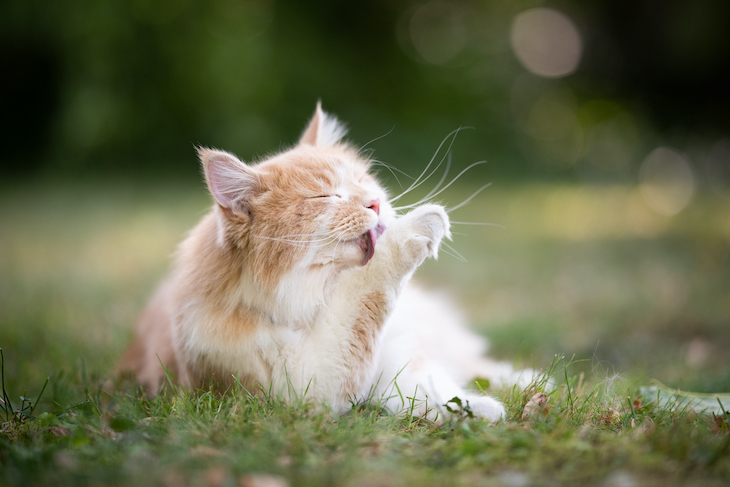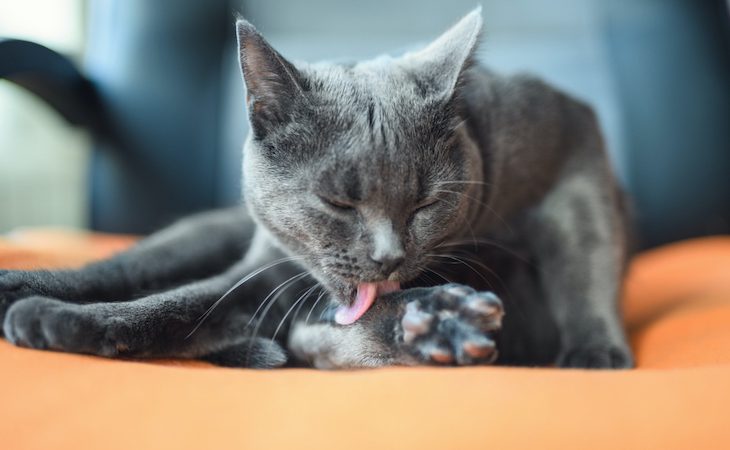Cats are typically very clean animals. However, they can suffer from a range of skin conditions due to parasites, fungi, allergies, and even stress. These often present themselves in the form of scabs once a lesion has been irritated. It’s therefore no surprise that seeing their skin like this, we ask ourselves: why does my cat have scabs? And what can I do to treat them?
To begin with, understanding why your cat has scabs will help you to know how to treat them. (Note that all cat breeds can suffer from such skin conditions.)
Why does my cat get scabs?
Your cat’s diet
A healthy cat will almost always have a beautiful coat and skin. While diet isn’t often the first thought if scabs are present, knowing that their diet plays a huge role in their health is important for skin health.
Various ingredients present in both dry and wet foods can cause allergic reactions in some cats. This may be something your vet takes into consideration as the first port of call. You might be advised to switch to a low-allergenic food type to help avoid such irritations.
Molting
Molting is a normal process for cats. However, depending on their environment, including weather changes, your cat may feel the need to aid the natural process. This can bring about excess scratching and cleaning.
If this is the case, you can help your cat by giving them a regular brush. This is particularly beneficial for medium-long and longhair cat breeds. First and foremost, this will help to reduce any potential scabbing. But it will also help to manage excess hair shed around your home and reduce any potential allergies for you and/or your household.
External parasites
As you’re probably already aware, there are many different types of parasites that enjoy feeding off our pets. External parasites such as fleas, scabies, ticks and mites (chiggers) can be a real headache. If infested, your cat will no doubt itch, scratch and lick excessively, especially in heavily infested areas. This in turn can cause bleeding and scab formation on your cat’s skin.
Ringworm
Despite its name, ringworm is a fungal skin infection that can not only affect our domestic fur friends but also humans. It can even be transmitted between humans and pets – known as zoonosis. This happens from coming into direct contact with the infected skin, which can also be found in bedding, carpets, on nail clippers, etc., as well as in soil.
Scabbing as a result of ringworm typically means the infection is well advanced. Early stages of infection are usually noticeable by the presence of dander (or dandruff) where clusters of hair have begun falling out.
Miliary dermatitis
By far the most common cause of miliary dermatitis is the result of flea bites. This allergy presents itself in the form of itchy, red patches. Much in the same way as with parasites, your cat will start to scratch and lick excessively. This inevitably leads to the development of scabs.
Other causes of miliary dermatitis include food allergies, lice, mites, and even auto-immune diseases.
Stress in cats
Stress can be difficult to detect in cats. If your cat has experienced a recent change to their environment, seen the arrival of a new person or animal in the household, had a change in diet, or experienced another similar significant change, they may become stressed. Understanding a cat’s body language is important here as you’re likely to witness abnormal behaviors such as excessive licking and scratching. These behaviors can in turn lead to raw skin patches followed by scabs.
Cat fights
Cats are territorial by nature and it’s not uncommon to hear outdoor cats have a nighttime battle for their turf. Unfortunately, these can lead to wounds, which in turn scab over to leave a nasty reminder of that turf war. Unless these wounds become infected, there is no reason but to leave the scab to form and let the wound heal itself.
Diseases
Other diseases such as feline immunodeficiency virus (FIV – similar to human HIV) and feline leukemia can also lead to excessive scratching. While not the only symptom, the formation of scabs can be an early sign of such diseases present in cats.

My cat is showing scabs. How do I treat them?
Make an appointment with your vet
First and foremost, getting your cat checked out by a vet will determine the underlying cause of your cat’s scabs. This is important in order to know the right treatment to administer. You may not explore this option if your cat only shows one small scab that heals nicely and they experience no further issues (possibly the result of a cat fight). However, persistent licking and scratching, or the presence of multiple scabs should always be investigated. You will know your cat best, so keep an eye on behavioral changes and/or changes to their coat.
Understanding your cat’s normal behavior will also be important to your vet. They will be sure to examine your cat thoroughly and ask you specific questions about changes to your pet’s life and/or environment, as well as behavior. They will also want to know where any former lesions or scabs have appeared. This will help them to build a picture when observing those they see at the time of examination. With all this information, your vet will be able to carry out the necessary assessments to determine what might be causing your cat’s skin condition. Finally, they may carry out further tests such as a blood analysis or skin biopsy.
Depending on the diagnosis, treatment options can vary and typically include topical creams or sprays, antibiotics or other tablets, food supplements or even a dietary change. Any changes needed to your cat’s diet will be directed by your vet and may also require a blood test to understand any underlying nutrient deficiencies.
Additional treatment solutions
If your cat’s scabs are a result of stress your vet is also likely to be able to tell you this. Depending on your vet’s recommendations, pheromone sprays and diffusers can aid with stress reduction.
Another option to consider includes consulting a feline behavioral specialist. This highly-skilled person can help identify key causes of stress for your cat. Very often, it is not necessary to pay for multiple consultations as the problems encountered are mild and can be resolved quickly.
Finally, skin cleaning solutions (for cats only!) can also be used to help prevent lesions from becoming infected. Always follow the directions on the bottle or as advised by your vet. Never use products designed for humans no matter how “harmless” they appear. These can make existing skin conditions much more severe and in some circumstances even cause burning and poisoning.

